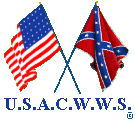E
Earthworks - Fortifications composed of banks of earth
and wood, rather than brick or stone, facing the enemy.
Elephant - Any level of combat. To see/meet the elephant was to
enter combat for the first time.
Embalmed Beef - A slang Civil War term for canned beef.
Embrasure - An opening cut through the wall, or parapet,
of a fortification to allow the artillery to fire through.
Enfield Model 1853 Rifle - Because it could fire the
.58 caliber U.S. minie ball, the Enfield Rifle was used by both sides in the
U.S. Civil War. It was the standard rifle of the British Army from 1853 thru
1867.
Enfilade - battery of guns placed at right angle to the
enemy's line.
Engagement - One of the highest levels of combat. During
the Civil War, the term was often used interchangeably with "Battle", although
"Battle", as used by the military, was considered a higher level of combat than
"Engagement".
Engineer Corps - A military organization involved in
skillfully laying out or constructing a military operation.
Envelopment - To attack the enemy's flank. A double
envelopment meant attacking both flanks of the enemy at the same time.
Envelopment was also used to describe a turning movement to the rear of the
enemy hoping to force him to vacate his position.
Epaulement - An elevation constructed in order to provide
protection from the fire of the enemy. It was usually composed of gabions
filled with earth, or sand bags.
RETURN TO
TOP OF PAGE
F
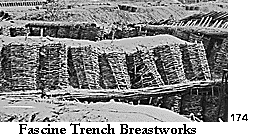 Fascine - A bundle of brushwood tied together and
used in entrenchments to support the earthen walls.
Fascine - A bundle of brushwood tied together and
used in entrenchments to support the earthen walls.
Feint - A small diversionary attack against an enemy's
position well away from the main attack point. A feint is meant to distract the
enemy and force him to pull troops away from the main attack point.
Flank - Either end of a battle line (a line of troops).
The flanks are normally considered more exposed and weaker than the rest of the
battle line.
Flank(ed); also Outflank(ed) - To go around (or have
gone around) the flank of an army.
Floating Battery - A battery of artillery mounted
upon a barge or raft. They were towed into desired firing positions
inaccessible by land.
Flying Battery - Two or more horse-drawn cannons
moving rapidly along the battle front, unlimbering, firing, limbering and
riding to another position. Confederate Maj. John Pelham made this procedure
famous at Fredericksburg.
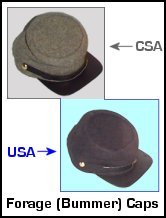
Forage - (1) An Army or individual living from the
land, obtaining food from the countryside, sometimes forcibly taking it from
civilians. (2) A military fatigue cap (sometimes called a
"bummer").
Fort - A strong or fortified place for protection
against the enemy.
Fortification: - Works erected to defend a place.
Frontal Assault - The type of assault that the CSA used
in Gettysburg, and the USA used at Cold Harbor. In the Civil war, a frontal
assualt almost always cost the attackers many more men than the defenders.
Furlough - A leave granted to a soldier by his superior.
The Furlough allowed a soldier to be away from his unit without being considered
AWOL (Absent without leave.)
RETURN TO
TOP OF PAGE
G
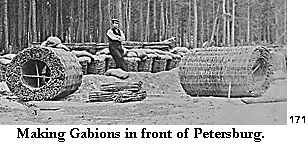 Gabion - A cylindrical basket, open at both ends, which,
after it was placed in position, was filled with dirt. It was used to stabilize
earthworks and protect against small arms fire.
Gabion - A cylindrical basket, open at both ends, which,
after it was placed in position, was filled with dirt. It was used to stabilize
earthworks and protect against small arms fire.
Garrison - Infantry, or other military personnel,
assigned to man a fort or fortress.
Grapeshot - Artillery ammunition similar in concept to
canister.
For example, the containers holding canister shot or grapeshot both
disintegrated upon firing and showered the enemy with metal balls. The main
difference was that grapeshot consisted of fewer and larger metal balls than
did canister.
The grapeshot balls were held together with iron rings or trussed up with
fabric and twine. (The latter was referred to as "quilted grape shot".)
It is often erroneously stated that grapeshot was purely naval ammunition but
grape was at least occasionally issued to field artillery. As a result,
the metal balls used in canister rounds, although of smaller size and larger
number than grapeshot, were informally called grape. By the time of the U.S. Civil
War, true grapeshot was reserved for use by Navy since it was found that canister
was more effective for field artillery.
Gunboat - A small armed vessel.
RETURN TO
TOP OF PAGE
H
Habeas Corpus - A legal instrument designed to prevent
someone from being imprisoned without trial or conviction. Lincoln suspended
Habeas Corpus throughout the United States during the war, which resulted in
approximately 18,000 civilians imprisoned without a trial. It was said that
the action by Lincoln kept Maryland in the Union. Congress, after the fact,
made Lincoln's actions legal in 1863. Jefferson Davis obtained the Confederate
Congress' approval to suspend Habeas Corpus as a way of enforcing the 1862
draft, but it was so disliked that it was seldom used.
Handspike - A four to six foot wooden pole used to move a cannon
to the left or right.
Hardtack - A hard square cracker made of flour, water
and salt. It was one of the major staples for both Northern and Southern
soldiers.
Haversack - A leather or linen bag issued to soldiers
and used to carry rations.
High Bridge - A bridge across the Appomattox River in Virginia
which required over sixty-foot high piers. It was the site of an April 1865
engagement that caused the Union approximately 800 casualties.
Horse Artillery - A artillery unit in which all the
cannoneers were mounted. These units were commonly used with the cavalry, but
they could also be used for supporting the advance or retreat of an army.
Hot Shot - A solid iron ball which was heated red-hot
before firing. Its purpose was to set fire to wooden vessels or wooden structures
inside forts.
Housewife - A small sewing kit, usually handmade,
carried by soldiers and sailors during the Civil War.
Howitzer
According to the U.S. Army, the Field Howitzer, 12-pounder:
* Fires 12-lb. projectiles (conical bolt, case, shell, canister).
* Has a bore diameter of 4.62 inches.
* Has a tube weight of 788 pounds, and is made of bronze.
* Has a range of 1,072 yards at 5 degrees elevation.
* Has a muzzle velocity of 1,200 feet per second.
* Was used as a high-trajectory antipersonnel weapon.
RETURN TO
TOP OF PAGE
I
Impressment - The seizure of private property. Federal
legislation let the military seize any property from civilians if it was needed
under emergency conditions. When martial law was declared in any of the southern
areas occupied by Union troops, anything of value was subject to impressment.
In the Confederacy, individual states and localities could authorize impressment.
In 1863 the Confederate Congress authorized impressment when it was deemed
necessary. This statute was appealed as a violation of states' rights and
quickly repealed. However, local and state impressment in the Confederacy
continued.
In the Air - A term used to describe the end of a line
of troops which has no protection.
Instant - A term used to indicate "a day of the current month."
For example, reference to an event of the 12th instant refers to an event
on the 12th of this month.
Invest - To envelope; to lay siege to.
Ironclad Ship - A 19th century warship having sides
armored with metal plates in order to protect it. Confederate ironclads had a
superstructure with sloped sides called a casemate.
RETURN TO
TOP OF PAGE
J
Jacknife - A knife with multiple blades that fold into
its case when not in use.
Jerusalem Overtaker - Civil War name for an artichoke. It
was called the Overtaker, since it has a tendency to "overtake" the garden in
which it is planted.
RETURN TO TOP OF PAGE
K
Kepi - A military cap having a close-fitting band, a
round top sloping toward the front, and a visor.
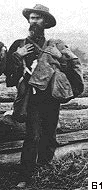 Knapsack - Similar to a canvas backpack with a wooden
frame, the knapsack was issued to carry a blanket, food, ammunition and other
items that the soldier needed. Not as flexible as the
Haversack, the knapsack's wooden frame wore against
the soldier's back and was eventually discarded. The soldiers replaced the
knapsack by rolling their belongings in a blanket which they carried over their
shoulder.
Knapsack - Similar to a canvas backpack with a wooden
frame, the knapsack was issued to carry a blanket, food, ammunition and other
items that the soldier needed. Not as flexible as the
Haversack, the knapsack's wooden frame wore against
the soldier's back and was eventually discarded. The soldiers replaced the
knapsack by rolling their belongings in a blanket which they carried over their
shoulder.
RETURN TO
TOP OF PAGE
L
Lamp Posts - Ten-inch projectiles fired by Federal
gunboats.
Limber - A two-wheeled horse-drawn vehicle that towed a
cannon and contained one ammunition box. When the cannon was attached to the
limber for transportation, it was said to be "limbered" and when the cannon was
disconnected from the limber, such as for firing, it was said to be
"un-limbered". Six horses were required to pull the limber and cannon.
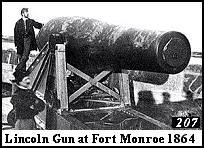
Lincoln Gun - A 15-inch Rodman cannon named in honor of Abraham
Lincoln. It had a range of nearly four miles using a 450 pound solid shot or 330
pound explosive shell. The 49,000 pound cannon was located at Fort Monroe.
Long Roll - A continuous drum roll used to call soldiers to
arms.
Lunette - A 2 or 3 sided field fort, an improvement on
the standard
redan by providing flanks. A weakness of
the lunette was that the rear was open and exposed to attack.
RETURN TO
TOP OF PAGE
M
Magazine - A realitively safe storage area for ammunition
and gunpowder on land and in ships.
Mine - During the Civil War it generally referred to a
system of tunneling under the enemy earthworks and detonating explosives to
create a crater or opening where troops could charge the enemy.
Minie Bullet (Minie Ball) - The Minie Bullet got its
name from one of its developers, Claude-Etienne Minie. It became the most used
bullet in the Civil War because it had improved accuracy and faster loading
compared to the musket.
Mortally Wounded - wounded to extent that death follows.
Mortar - A muzzle-loading cannon used to fire
projectiles at high angles.
Mounted Infantry - Infantry that uses horses for travel
but, as a rule, does not fight from horseback (As the cavalry does).
Muster(ed) - To enroll formally. Usually used with "in"
or "into" (i.e. He was mustered into the army).
RETURN TO
TOP OF PAGE
N
Napoleon Cannon - The most famous cannon of the Civil
War. The Bronze gun was in heavy use near the end of the war.
According to the U.S. Army, the Napoleon Cannon:
* Fires 12-lb. projectiles (solid, case, shell, canister).
* Has a bore diameter of 4.62 inches.
* Has a tube weight of 1,227 pounds, and is made of bronze.
* Has a range of 1,619 yards at 5 degrees elevation.
* Has a muzzle velocity of 1,485 feet per second.
* Was used for close infantry support in wooded areas, and as a final
defense.
Noncombatants - In the Civil War noncombatants included
surgeons, chaplains, nurses, sudlers and others not fighting with the armies.
If a noncombatant was captured he or she was immediately released.
Nullification - Proclamations by Southern States
declaring Federal Laws null and void within their boundaries.
RETURN TO
TOP OF PAGE
|
